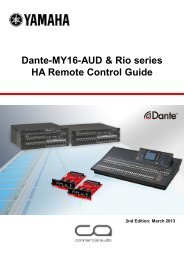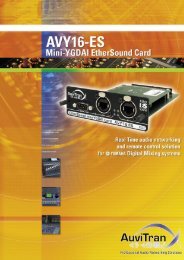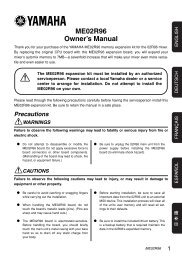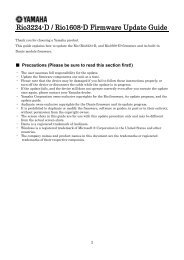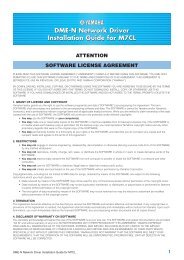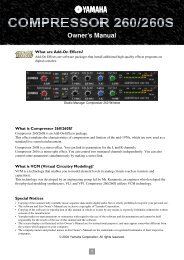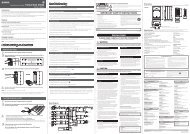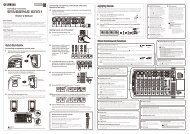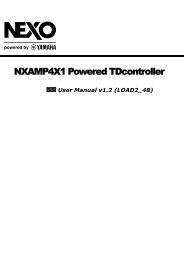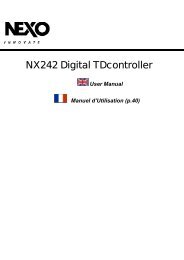Yamaha Digital Audio System Design Guide 8.42MB
Yamaha Digital Audio System Design Guide 8.42MB
Yamaha Digital Audio System Design Guide 8.42MB
Create successful ePaper yourself
Turn your PDF publications into a flip-book with our unique Google optimized e-Paper software.
27<br />
MADI MADI<br />
Studio<br />
In the following example, a MADI system is confi gured for a production facility comprising two small editing studios, a large recording studio,<br />
and a main studio capable of collecting and distributing audio signals to and from the other studios. Because MADI enables simple, point-topoint<br />
transfer of multichannel digital audio with excellent signal-to-noise ratios, it is well suited to the transfer of audio signals between studios<br />
located within the same facility (where cable lengths are relatively short).<br />
Analog audio signals input into a DM1000 VCM in each studio are transferred via coaxial cables between MY16-MD64 Mini-YGDAI interface<br />
cards for MADI. In the main studio, a DM2000 VCM receives these signals via an additional three MY16-MD64 cards, each capable of handling<br />
16 channels. The DM2000 VCM is also equipped with two MY16-EX Mini-YGDAI expansion cards (used in combination with another MY16-<br />
MD64), allowing it to simultaneously transfer up to 48 channels of digital audio to a DAW system in the machine room.<br />
Studio 1 Studio 2 Studio 3<br />
C<br />
C<br />
Main <strong>Audio</strong> Studio<br />
Equipment List<br />
B<br />
<strong>Yamaha</strong> <strong>Digital</strong> <strong>Audio</strong> <strong>System</strong> <strong>Design</strong><br />
Screen<br />
C C C D D<br />
Manufacturer Equipment<br />
Model Qty. Note<br />
A <strong>Yamaha</strong> <strong>Digital</strong> Production Console DM2000 VCM 1<br />
B <strong>Digital</strong> Mixing Console DM1000 VCM 3<br />
C <strong>Digital</strong> I/O Card MY16-MD64 7<br />
D <strong>Digital</strong> I/O Card MY16-EX 2<br />
E RME MADI PCI Expess Card HDSPe MADI 1<br />
C<br />
Main Mixer<br />
A<br />
B<br />
C<br />
Machine Room<br />
B<br />
DAW with NUENDO<br />
E<br />
Coaxial cable (Tx)<br />
Coaxial cable (Rx)<br />
Cat5e cable (STP only)<br />
Large Live SR<br />
This section describes a MADI-based solution for sound reinforcement in a large concert venue and comprising 48 input and 32 output<br />
channels. Despite being as simple to use as traditional analog cabling, MADI cabling offers an added labor-saving advantage in the form<br />
of lower weight and overall length. Using a MADI bridge, redundancy is established for cabling between the stage and FOH. And as MADI<br />
facilitates the distribution of signals from a bridge (essentially operating as a multichannel splitter), the FOH MADI bridge can transmit two<br />
identical multichannel outputs to an outside broadcasting truck and a recording mobile, both of which are located outside the venue. It should<br />
be noted that the MADI bridge also sends the same output to a DAW workstation located close to the FOH console.<br />
On stage, meanwhile, the monitor console uses dedicated lines to control six AD8HR units with HA Remote signals. Instead of stage monitor<br />
speakers, supporting musicians at the back of the stage utilize the AVIOM monitor system, which is based on the proprietary A-Net audio<br />
network. Specifi cally, these musicians use network-based AVIOM A-16 II personal mixers to create their preferred monitor mixes from incoming<br />
monitor signals. Normally, it is not possible for differing digital audio formats to coexist on the same audio lines. In this confi guration, however,<br />
the PM5D monitor console is equipped with both MADI and AVIOM interface cards so that it can also function as a format converter, facilitating<br />
simultaneous operation of both MADI and AVIOM (A-Net) systems.<br />
G<br />
N N N<br />
J<br />
D<br />
D<br />
D<br />
E<br />
E<br />
F<br />
A<br />
B<br />
Mics 25-32<br />
Mics 33-40<br />
Mics 41-48<br />
C C<br />
F.O.H Console<br />
Mics 1-8<br />
Mics 9-16<br />
Mics 17-24<br />
Equipment List<br />
Manufacturer Equipment Model Qty. Note<br />
A <strong>Yamaha</strong> <strong>Digital</strong> Mixing Console PM5D-RH V2 2<br />
B MADI Interface Card MY16-MD64 2<br />
C I/O Expansion Card MY16-EX 4<br />
D ADC/8ch Remote PreAmp AD8HR 6<br />
E Speaker Processor SP2060 4<br />
F DA Converter DA824 2<br />
G <strong>Digital</strong> I/O Card MY8-AE 2<br />
H RME MADI Switcher/Router MADI Bridge 2<br />
I CoaxialOptical Converter MADI Converter 1<br />
J MADI AES/EBU Format Converter ADI-6432 2<br />
K MADI PCI Express Card HDSPe MADI 1<br />
L — Rack Mount PC — 1<br />
M AVIOM A-Net Console Card 16/o-Y1 1<br />
N Personal Mixers A-16II unlimited<br />
O Neutrik Optical Cable Opticalcon/2 pole 1<br />
G<br />
M<br />
I<br />
H<br />
A<br />
H<br />
B C C<br />
Monitor Console<br />
O<br />
L<br />
K<br />
<strong>Yamaha</strong> <strong>Digital</strong> <strong>Audio</strong> <strong>System</strong> <strong>Design</strong> 28<br />
J<br />
D<br />
D<br />
D<br />
E<br />
E<br />
F<br />
Broadcast Mobile<br />
Recording Mobile<br />
Optical cable<br />
Coaxial (up) cable<br />
Coaxial (down) cable<br />
Cat5e cable<br />
D-sub 25-pin (male) cable<br />
HA Remote (D-sub 9-pin)<br />
Analog



